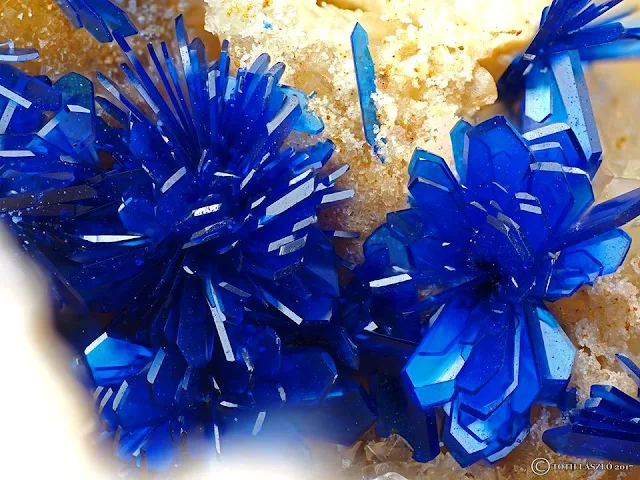Azurite Crystal Flowers
Azurite is a common secondary carbonate in the oxidation zone of copper deposits where it coexists with other secondary copper minerals such as malachite. Its name comes from "lazhward" Persian (blue) by allusion to its color, a beautiful night blue. It is a mineral known since Antiquity.
Azurite crystallizes in the monoclinic system. Large crystals are dark blue, often prismatic. Azurite specimens can be massive to nodular or can occur as drusy crystals lining a cavity.
The crystals are mostly well formed and large. They have various facies, often tabular or elongated, more rarely short prismatic or pseudorhombohedral. The faces are often slightly striated, the aggregates in rosettes of prismatic crystals are more anecdotal. Azurite is more rarely massive, in concretions or stalactites.
 |
| Spectacular Azurite Crystal Flowers in Vug.
The specimen in the photo is From: Kozári Quarry, Pécs, Hungary. Photo Credit: Tóth László |
Azurite is found in the same geologic settings as its sister mineral, malachite, though it is usually less abundant. Both minerals occur widely as supergene copper minerals, formed in the oxidized zone of copper ore deposits. Here they are associated with cuprite, native copper, and various iron oxide minerals.
Properties of Azurite
- Formula: Cu3(CO3)2(OH)2
- Color is azure, deep blue or pale blue if found in small crystals or crusts.
- Luster is vitreous to dull depending on habit.
- Transparency: Transparent if in thin crystals, otherwise translucent to opaque.
- Crystal System is monoclinic; 2/m.
- Crystal Habits crystals are irregular blades with wedge shaped terminations. Also, aggregate crusts and radiating, botryoidal, nodular and earthy masses.
- Cleavage is good in one direction and fair in another.
- Fracture is conchoidal and brittle.
- Hardness is 3.5-4.
- Specific Gravity is 3.7+ (heavier than average).
- Streak is blue.
- Associated Minerals are numerous and include malachite limonite, calcite, cerussite, quartz, chalcopyrite, native copper, cuprite, chrysocolla, aurichalcite, shattuckite, liroconite, connellite and other oxidized copper minerals.
- Notable Occurrences include numerous localities worldwide, but special localities produce some outstanding specimens especially from Lasal, Utah; Bisbee, Arizona and New Mexico, USA; Mexico; Tsumeb, Nambia; Shaba, Congo; Toussit, Morocco; Australia and in many locations in Europe.
- Best Field Indicators are color, softness, crystal habits and associations.

%20(1).webp)






